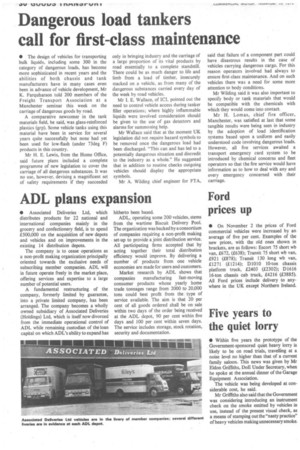Dangerous load tankers call for first-class maintenance
Page 32

If you've noticed an error in this article please click here to report it so we can fix it.
• The design of vehicles for transporting bulk liquids, including some 300 in the category of dangerous loads, has become more sophisticated in recent years and the abilities of both chassis and tank manufacturers have in many cases even been in advance of vehicle development, Mr K. Farquharson told 200 members of the Freight Transport Association at a Manchester seminar this week on the carriage of dangerous goods by road.
A comparative newcomer in the tank materials field, he said, was glass-reinforced plastics (grp). Some vehicle tanks using this material have been in service for several years quite successfully but none had yet been used for low-flash (under 73deg F) products in this country.
Mr H. E. Lewis, from the Home Office, said future plans included a complete programme of new legislation to cover the carriage of all dangerous substances. It was no use, however, devising a magnificent set of safety requirements if they succeeded only in bringing industry and the carriage of a large proportion of its vital products by road essentially to a complete standstill. There could be as much danger to life and limb from a load of timber, insecurely stacked on a vehicle, as from many of the dangerous substances carried every day of the week by road vehicles.
Mr I. E. Wallace, of ICI, pointed out the need to control vehicle access during tanker filler operations; where highly inflammable liquids were involved consideration should be given to the use of gas detectors and alarms for summoning help.
Mr Wallace said that at the moment UK legislation did not require hazard symbols to be removed once the dangerous load had been discharged. "This can and has led to a potentially dangerous situation and discredit to the industry as a whole." He suggested that in addition to routine checks outgoing vehicles should display the appropriate symbols.
Mr A. Wilding chief engineer for FTA, said that failure of a component part could have disastrous results in the case of vehicles carrying dangerous cargo. For this reason operators involved had always to ensure first-class maintenance. And on such vehicles there was a need for some more attention to body conditions.
Mr Wilding said it was also important to specify body or tank materials that would be compatible with the chemicals with which they would come into contact.
Mr H. Lomas, chief fire officer, Manchester, was satisfied at last that some tangible results were being seen in industry by the adoption of load identification systems based upon a uniform and easily understood code involving dangerous loads. However, all fire services awaited a transport emergency card system to be introduced by chemical concerns and fleet operators so that the fire service would have information as to how to deal with any and every emergency concerned with their carriage.




































































































































